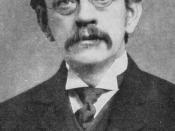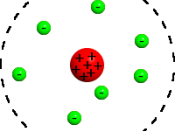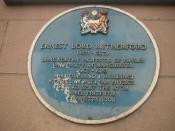Rutherford's Gold Foil Experiment
Rutherford started his scientific career with much success in local schools leading to a scholarship to Nelson College. After achieving more academic honors at Nelson College, Rutherford moved on to Cambridge University's Cavendish laboratory. There he was lead by his mentor J.J. Thomson convinced him to study radiation. By 1889 Rutherford was ready to earn a living and sought a job. With Thomson's recommendation McGill University in Montreal accepted him as a professor of chemistry. Upon performing many experiments and finding new discoveries at McGill university, Rutherford was rewarded the nobel prize for chemistry. In 1907 he succeded Arthur Schuster at the University of Manchester. He began persuing alpha particles in 1908. With the help of Geiger he found the number of alpha particles emitted per second by a gram of radium. He was also able to confirm that alpha particles cause a faint but discrete flash when striking luminescent zinc sulfide screen.
These great accomplishments are all overshadowed by Rutherford's famous Gold Foil experiment which revolutionized the atomic model.
This experiment was Rutherford's most notable achievement. It not only disproved Thomson's atomic model but also paved the way for such discoveries as the atomic bomb and nuclear power. The atomic model he concluded after the findings of his Gold Foil experiment have yet to be disproven. The following paragraphs will explain the significance of the Gold Foil Experiment as well as how the experiment contradicted Thomson's atomis model.
Rutherford began his experiment with the philosophy of trying 'any dam fool experiment' on the chance it might work.1 With this in mind he set out to disprove the current atomic model. In 1909 he and his partner, Geiger, decided Ernest Marsden, a student of the University of Manchester, was ready for a real...



Good
needs sources though. Where are they?
Its alright though informative but is it correct?
0 out of 0 people found this comment useful.